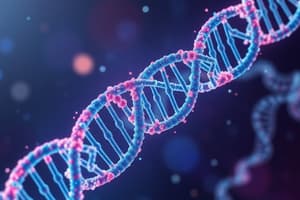Podcast
Questions and Answers
Which nucleotide is not part of DNA?
Which nucleotide is not part of DNA?
- Uracil (correct)
- Cytosine
- Adenine
- Thymine
What is the primary role of tRNA in the translation process?
What is the primary role of tRNA in the translation process?
- Carrying genetic code from DNA
- Synthesis of ribosomal RNA
- Bringing amino acids to ribosomes (correct)
- Serving as a template for mRNA synthesis
Which process occurs in the nucleus and involves RNA polymerase?
Which process occurs in the nucleus and involves RNA polymerase?
- Transcription (correct)
- Replication
- Gene regulation
- Translation
During gene regulation, which elements play a role in increasing gene expression?
During gene regulation, which elements play a role in increasing gene expression?
What is the result of the Polymerase Chain Reaction (PCR)?
What is the result of the Polymerase Chain Reaction (PCR)?
Which type of RNA is a structural component of ribosomes?
Which type of RNA is a structural component of ribosomes?
What is a significant characteristic of proteins with regard to their structure?
What is a significant characteristic of proteins with regard to their structure?
Which genome editing tool allows precise modifications to DNA?
Which genome editing tool allows precise modifications to DNA?
Flashcards are hidden until you start studying
Study Notes
Overview of Molecular Biology
- Focuses on biological processes at the molecular level.
- Studies the interactions between various cellular systems, including DNA, RNA, proteins, and their biosynthesis.
Key Concepts
DNA (Deoxyribonucleic Acid)
- Carries genetic information.
- Double helix structure composed of nucleotides (adenine, thymine, cytosine, guanine).
- Replication: DNA duplicates itself prior to cell division.
RNA (Ribonucleic Acid)
- Involved in protein synthesis.
- Types of RNA:
- mRNA (messenger RNA): Carries genetic code from DNA to ribosomes.
- tRNA (transfer RNA): Brings amino acids to ribosomes during translation.
- rRNA (ribosomal RNA): Integral part of ribosome structure and function.
Proteins
- Made up of amino acids - chains folded into specific shapes.
- Function depends on structure (e.g., enzymes, structural proteins, signaling molecules).
- Synthesized through translation of mRNA by ribosomes.
Key Processes
Transcription
- The process by which mRNA is synthesized from a DNA template.
- Occurs in the nucleus (in eukaryotic cells).
- Involves RNA polymerase enzyme.
Translation
- The process of synthesizing proteins from mRNA.
- Occurs in ribosomes in the cytoplasm.
- Involves the assembly of amino acids in the order specified by the mRNA sequence.
Gene Regulation
- Mechanisms that increase or decrease the expression of specific genes.
- Involves transcription factors, enhancers, and silencers.
- Essential for cellular differentiation and response to environmental changes.
Techniques in Molecular Biology
- Polymerase Chain Reaction (PCR): Amplifies DNA sequences.
- Gel Electrophoresis: Separates DNA/RNA/proteins based on size and charge.
- Cloning: Producing copies of DNA fragments or entire organisms.
- CRISPR-Cas9: A genome editing tool that enables precise modifications to DNA.
Applications
- Genetic engineering: Modification of organisms for desired traits.
- Biotechnology: Use of living systems to develop products, including pharmaceuticals.
- Medicine: Understanding diseases at a molecular level, aiding in diagnostics and therapeutics.
Important Figures
- James Watson and Francis Crick: Discovered the double helix structure of DNA.
- Rosalind Franklin: Contributed to the understanding of DNA through X-ray diffraction.
Conclusion
- Molecular biology provides insight into the fundamental processes that drive life.
- Integrates knowledge from genetics, biochemistry, and cell biology for advancements in science and medicine.
Overview of Molecular Biology
- Examines biological processes at the molecular level, focusing on cellular system interactions.
Key Concepts
DNA (Deoxyribonucleic Acid)
- Primary carrier of genetic information.
- Comprised of a double helix structure formed by nucleotides: adenine (A), thymine (T), cytosine (C), and guanine (G).
- Undergoes replication to ensure genetic continuity during cell division.
RNA (Ribonucleic Acid)
- Essential for protein synthesis through its various forms.
- Types of RNA:
- mRNA (messenger RNA): Transfers genetic code from DNA to ribosomes.
- tRNA (transfer RNA): Delivers amino acids to ribosomes during protein synthesis.
- rRNA (ribosomal RNA): Forms a crucial part of ribosome structure and function.
Proteins
- Composed of chains of amino acids that fold into specific three-dimensional shapes.
- Functionality is determined by their structure, including roles as enzymes, structural components, and signaling molecules.
- Synthesized via translation of mRNA by ribosomes.
Key Processes
Transcription
- Involves synthesis of mRNA from a DNA template.
- Takes place in the nucleus of eukaryotic cells.
- Mediated by the enzyme RNA polymerase.
Translation
- The assembly of proteins from mRNA occurs in ribosomes located in the cytoplasm.
- Amino acids are linked together in a sequence dictated by the mRNA message.
Gene Regulation
- Mechanisms that modulate the expression levels of specific genes.
- Involves components like transcription factors, enhancers, and silencers for precise control.
- Crucial for processes such as cellular differentiation and adaptation to environmental changes.
Techniques in Molecular Biology
- Polymerase Chain Reaction (PCR): Facilitates the amplification of specific DNA sequences.
- Gel Electrophoresis: Used to separate nucleic acids and proteins based on size and charge.
- Cloning: Involves creating copies of specific DNA segments or entire organisms.
- CRISPR-Cas9: A genome editing technology that allows for targeted modifications of DNA.
Applications
- Genetic Engineering: Alters organism traits for improved characteristics.
- Biotechnology: Leverages biological systems to create products like pharmaceuticals.
- Medicine: Enhances understanding of diseases at a molecular level, aiding in diagnosis and treatment.
Important Figures
- James Watson and Francis Crick: Pioneered the double helix model of DNA structure.
- Rosalind Franklin: Key in the discovery of DNA’s structure through her X-ray diffraction work.
Conclusion
- Molecular biology offers critical insights into the mechanisms of life.
- Integrates genetics, biochemistry, and cell biology, driving advancements in scientific research and medical applications.
Studying That Suits You
Use AI to generate personalized quizzes and flashcards to suit your learning preferences.




